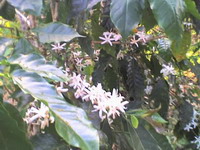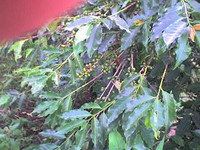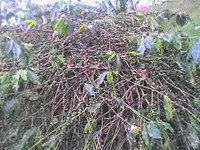|
The bushes are ( topography allowing ) planted 5 feet apart along the slope, and 10 feet apart, up/down the slope, 872 to the acre: the wide,10 foot, gap, ( which is reduced to about 5 feet, when the bushes are fully grown ) a rough pathway, between the bushes, along the slope, makes it a lot easier to pick the crop, and maintain the bushes. On the steepest of slopes, some terracing of the slope is necessary, to give the coffee bushes a stronger "base" on which to grow, and help them survive the inevitable, storms and hurricanes. A perfect plantation will have the appearance of a series of parallel "hedges", running with the slope, with a path between the hedges. It is very rare to see a plantation, like this, as the bushes get damaged by winds and infections, and replaced with new ones. The shade plants ( fruit trees, and Bananas: and any free trees given to the farmers by the Forestry Commission, which are usually Blue Mahoe, or Pine trees ) are planted every 20 to 30 feet along the edges of the "path": these shade plants also provide fruits, and in the very long term, lumber. It is the unique climate of these Blue Mountains that creates the shade, with the legendary "mists": during the ripening season for the coffee berries, the mists shade the plants from the full glare of the sun: usually the mists arrive late morning, shade the coffee from the hottest of the midday sunshine, before fading away in the afternoon. The coffee gets the full unobstructed sunshine for a couple of hours in the morning, and evening: the mists also keep the climate cool and damp, with just the occasional rain shower in the early afternoon. For us, the main use of the shade trees we plant, is for the secondary crops ( Bananas, and Citrus fruits, for the main part ) and to provide some protection for the newly planted coffee suckers so that they don't dry out in the summer heat. Left alone, the bush will grow into a tree, which can be 30 to 40 feet high: and produces very little fruit, as well as being almost impossible to pick!!
The flowers and fruit are only borne on the old growth, so there are never any fruits on the outer parts of the shoots, that grew this season. From the above picture you can clearly see the colour change along the shoots, the new growth is much greener, than the older, brownish parts. The leaves are borne on the new growth, at the ends of the twigs. At the top right, you can see a couple of very new leaves, which start off a pale brown colour, before maturing, filling with Chlorophyll, and turning green. A "perfect" well maintained, mature, coffee bush will appear to be a "green, leaf covered, rounded cone", the fruits well hidden inside the outer leaf cone, and not easily visible, until they ripen, and turn cherry-red.
Occasionally, a bush will "over flower" and produce a massive amount of fruit: the leaves fall off ( to put the energy into the fruits ) and the bush often dies, shortly afterwards: if it survives, it will be at least one full season, before it bears more than a "token" crop. Our "record" to date, one bush produced over 20 pounds of cherries ( almost 4 times the expected crop ) and promptly died! When the coffee bush is matured, and fruiting nicely, the method of pruning changes: all the small, new leafing shoots, inside the "canopy" of the bush are pruned off ( they get less light, develop slowly, and are a "drain" on the plants resources: so cut them off! ) care must be taken to ensure that sufficient new growth is left on the bush, the future coffee-bearing part of the bush! We have 3 main methods of propagating our new coffee bushes:- By cuttings; not the most successful method, as only about 20% of the cuttings "survive": they do not grow the long single root, quickly: which makes them susceptible to storm winds, until they are fully established, which can be 2 or 3 years, after planting out. The amount of space, and special care, required to grow cuttings to a maturity level where they will be able to survive the "weather", is not worth the results: it is very much easier to use one of the other 2 methods: unless propagating a "special" coffee bush, without waiting for it to produce the seeds and grow those; a cutting is ( in effect ) a clone of the original. "Bush Suckers"; wild seeded coffee bushes, which can be found all over the area: some of them grow from dropped cherries during the harvesting, some from the mounds of coffee trash discarded from the local pulperies, and a few must be spread by birds, who eat the cherries, and distribute the coffee seeds, all around. We try to get them 2 or 3 years old, when they are 2 to 3 feet high, and transplant them: they take about 2 or 3 months to fully "settle in", and start to grow, vigorously. The loss rate is about 15%, usually they just die within the first few weeks after trans-planting. The exposed roots are very susceptible to drying out, and the plant will not survive unless the roots are kept well wet ( but not immersed in water ) until they are planted out: wrapping with well wetted newspaper, and put in a plastic bag; usually suffices, for the few hours they are out of the ground. This is our preferred method, as it gives us a good 2 years growth, ahead of growing from a seed: it also allows us to identify the variety ( Blue Mountain, or Geisha ) and plant appropriately. By seeds: most of our new coffee bushes are grown from seeds: there are almost always, a few beans ripening on the bushes, well outside the picking seasons: after checking for any borer beetle infection, we use these beans for the seeds. Spreading them in a large, deep seed tray, under half an inch of soil, and kept well watered; but never allowing them to get waterlogged, or they just rot; after germination, if the roots get too wet, they die. They can take a very long time to germinate, anywhere from 2 to 4 months if the seeds have dried out; relatively fresh seeds, can germinate in just a couple of weeks, if conditions are favourable. As soon as they have developed their second or third, pair of "adult" leaves, they are transplanted into plastic plant pots ( minimum of 8 inches deep of soil ) in a good compost/soil mixture. We leave the pots outside, not sheltered from the rain, but partially protected from the full sun, especially during the hottest part of the day. The pots are stood on wooden slats a couple of inches off the ground, which helps both with drainage, and keeping the slugs off the new plants; they are watered regularly to both keep the soil moist, and prevent the soil ( we use black plastic polythene pots ) around the roots getting too hot in the heat of the midday sun. To be continued ... Best wishes to all, my readers. Robin Plough, friend of www.coffee4dummies.com For questions about JBM, mail to: robin.plough@gmail.com |
Growing Coffee. Part 2
Growing Coffee. Part 2








